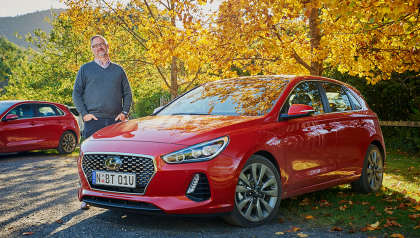If you’re ever in the mood to challenge friends and family to an impromptu round of automotive word association, please don't. It's better to let people suspect you’re a bit of a loser than to shout it from the rooftops.
Well, maybe you're not a total loser (I'd probably quite like you, for example), but I’m guessing you know your way around a good chemistry joke.
Anyway, hypothetically, the overwhelming response to the word 'Honda' would be 'Civic'; a nameplate that’s been part of the Australian landscape for 45 years and, with the arrival of the current model, no less than 10 generations.
The sedan version of the latest Civic arrived last year, with the hatch added to the line-up just two months ago. And this is the sporty RS, a car Honda says will: “Turn heads as you turn corners”. Bet you wish you’d come up with that one. If you had you'd be in advertising, and probably rich.
.jpg)
Honda Civic 2017: RS
| Engine Type | Turbo 4, 1.5L |
|---|---|
| Fuel Type | Unleaded Petrol |
| Fuel Efficiency | 6.1L/100km (combined) |
| Seating | 5 |
| Price From | $19,250 - $24,310 |
| Safety Rating |
|
Is there anything interesting about its design?
6 / 10
One person’s interesting is another person’s wildly confronting, but hats off to Honda for pushing the Civic design boat some way out from shore.
In evolving the ‘distinctive’ direction set by the preceding model, Honda has taken the risk of polarising opinion, and there’s little doubt the Civic RS’s angular, almost jagged, exterior forms stand it apart from the small hatch masses.
A riotous mix of curves, edges and channels come together to form an angry expression, with sharply tapering headlights sitting inside a blacked-out grille, located above oversize air intakes. Honda calls it ‘wing face’, which sounds like a Transformer bot. We call it 'whale shark approaching'.
The side profile curves gently across the turret, although the guards and doors are carved up by a mixture of hard shoulder lines, scalloped recesses, and perfectly radiused wheelarches.
.jpg)
Then, the rear goes full-on Star Wars with two spoilers and a diffuser shouting aero function, while pointy tail-lights and a replay of the huge, gill-like air vents scream styling form.
Inside, things calm down appreciably, with a relatively restrained mix of simple, broad surfaces blending ‘leather appointed’ seat trim with good quality materials on the dash and doors. A sleek 7.0-inch colour touchscreen sits discreetly in the centre of it all.
.jpg)
Sadly the more excitable members of Honda design team couldn’t help themselves. The instruments, including a large tachometer and digital speedo, are housed inside a compact binnacle, the three-part segmentation of which is plucked straight out of Luke Skywalker’s X-Wing.
Then you lift the bonnet.
.jpg)
Three decades ago, the genius of Honda’s design was everywhere, including the presentation of its road and race engines. The corporation’s branding proudly adorned the black cam cover of the humble four cylinder sitting under the Civic’s bonnet in the same way it sat on the magnificent V12 bolted into Ayrton Senna’s McLaren Formula One car.
Sadly, McLaren’s currently less-than-stellar relationship with Honda in grand prix racing parallels the decline of the Civic’s engine bay presentation. Don’t bother cracking open the hood to impress your friends, it’s a dog’s breakfast in there.
How practical is the space inside?
7 / 10
At 4.5m long, 1.8m wide, and just over 1.4m high, the Civic RS hatch is in the same dimensional territory as its sworn market enemies, the Mazda3 SP25 GT, and Toyota’s Corolla ZR; with this trio also sharing an identical 2.7m wheelbase.
There’s plenty of space for front-seat occupants, with heaps of storage including a respectable glove box, a lidded bin between the seats with two cupholders in front of it, as well as a tricky split-level oddments space in front of the gearshift. Door pockets offer space for modest bottles and there’s a 12-volt outlet in the console.
.jpg)
Slip into the back seat, and sitting behind the driver’s seat (set for this tester’s 183cm frame) there’s good, rather than great, head and legroom on offer (ample for kids up to teenagers), as well as a pair of cupholders in the folding centre armrest, plus pockets in the doors with just enough room for medium-size bottles. Demerit points for no adjustable air vents in the rear.
.jpg)
Luggage capacity is a modest 380 litres with the 60/40 split rear seats upright, and volume roughly doubles when they’re folded down. In that position, the base of the rear seat backs create a speed bump across the load space and an angled ramp towards the front seats, rather than a flat floor.
.jpg)
That said, there are four tie-down anchor points, and a nifty cargo cover that retracts laterally, neatly avoiding the need to remove a cargo blind bar or rigid parcel shelf from between the rear wheel arches.
.jpg)
The spare is a space saver sitting under the floor, and there’s decent lighting back there if you do need to change a flat.
.jpg)

Does it represent good value for the price? What features does it come with?
7 / 10
Weighing in at $32,290, the Civic RS hatch is coming close to the price ceiling for mainstream hatches in this market.
For that amount of money, along with its sporty, ‘warm hatch’ positioning, the RS has to deliver on standard equipment, and the list is lengthy.
For a start, this car incorporates enough LED’s to light up a Westfield Christmas tree, with the intense little diodes plugged into the (auto) headlights, fog lights, DRLs and tail-lights.
.jpg)
Then you can add ‘Advanced Display Audio’, including the 7.0-inch colour touchscreen, Apple CarPlay, Android Auto, digital radio, Bluetooth connectivity and 452 watts’ worth of 10-speaker premium sound.
There’s also cruise control (with speed limiter), front and rear parking sensors, keyless entry and start, auto headlights, rain-sensing wipers, dual zone climate control air, 17-inch alloy wheels, an electric sunroof, ‘leather appointed’ trim, plus heated front seats with eight-way power adjustment on the driver’s side.
Another, more debatable inclusion is ‘LaneWatch’, a camera-based system which displays an image of whatever is, or isn’t, in your blind spot on the centre screen as soon as the left indicator is activated. Jump to the safety section for a dissection of its relative merits.
What are the key stats for the engine and transmission?
7 / 10
The Civic RS hatch is powered by a 1.5-litre all-alloy, four-cylinder petrol engine featuring double overhead cams, direct-injection, ‘VTEC’ (Variable Valve Timing and Lift Electronic Control) and a single ‘low-inertia, high-response’ turbocharger.
The exhaust port is cast directly into the cylinder head, side-stepping the need for a traditional (heavier) manifold, and Honda says reducing internal friction via the use of exotic materials (including ion-plated piston rings and ‘silent’ chain drives) was a particular engineering focus.
The end result is 127kW at 5500rpm and 220Nm across a broad plateau from 1700-5500rpm.
It’s matched with a CVT auto, driving the front wheels, and equipped with a ‘G-Design Shift’ set-up using specific logic to create stepped ratios as vehicle speed increases (exploitable through wheel-mounted paddles).
How much fuel does it consume?
7 / 10
Honda claims 6.1L/100km economy for the combined (urban, extra-urban) cycle, with the RS emitting 142g/km of CO2 in the process.
Over roughly 300km of city, suburban and freeway driving we recorded 7.0L/100km, courtesy of the on-board trip computer.
Despite the engine’s sophisticated injection and induction tech, it’ll run happily on 91RON standard unleaded, and you’ll need 47 litres of it to fill the tank. On our figures, that capacity translates to a range of 670km.
What's it like to drive?
7 / 10
The Civic RS might look like a weapons-grade super hatch, ready to light its afterburners and atomise the bitumen, but it’s really not.
In fact, we suffered the ironic ignominy of an enthusiastic boy racer in an early ‘90s Civic, finished in a distinctive shade of Leyton House aqua (there’s one for the F1 fans), sending obvious ‘I want to race you’ moves our way.
Aside from the fact it was never going to happen, no matter what car we were in, the RS simply doesn’t have the performance bite to match its visual bark.
Although Honda isn’t quoting a specific 0-100km/h acceleration time, you can expect a number in the mid- to high-seven second bracket. And while that’s far from sluggish, it’s not blisteringly quick, either.
Yes, the (relatively modest) peak torque figure of 220Nm is available from just 1700rpm all the way to 5500rpm, at which point 127kW of peak power takes over. But those numbers simply aren’t big enough to shift more than 1.3 tonnes with anything other than moderate force. And the (fuel) efficient but drony CVT auto isn’t the most dynamic way to transfer drive, even in ‘manual’ mode.
On the upside, ride quality from the strut front, multi-link rear suspension is good, without compromise to overall dynamics.
The RS is fitted with Honda’s ‘Agile Handling Assist’ system; essentially torque vectoring by braking, to enhance initial turn-in response, and reduce understeer, and the car remains well buttoned down, even in quick corners.
Pushing along a favourite backroad, grip from the 215/50 x 17 Bridgestone Turanza rubber is impressive, the variable ratio, electrically assisted steering doesn’t come to the party with huge amounts of road feel, but braking is reassuringly progressive and strong.
The driver’s seat combines comfort with excellent lateral support (heating in the front pair is a boon on chilly mornings), and the ergonomics are hard to fault, from clear instruments to simple, intuitive controls.
That said, a large black mark goes against placement of the lower of two rear spoilers directly in the driver’s line of rear vision. Doh! And night-time resolution from the reversing camera is rubbish.
Then there’s LaneWatch. While the rear-facing camera mounted in the passenger side mirror adds a helpful side view to supplement the reversing picture when parking, we found the automatic switch to a blind-spot view on the centre screen it provides when changing lanes as disconcerting as it is helpful (especially with dazzling headlights appearing at night).
It's possible that it's something that would become natural and normal over time, but let’s just say we were relieved to discover it can be switched off via a few steps in the ‘i-MID’ information display.
Warranty & Safety Rating
What safety equipment is fitted? What safety rating?
8 / 10
All Honda Civic hatch variants score a maximum five ANCAP stars, with a lengthy list of standard active and passive safety features included.
Active safety tech includes the LaneWatch system, ‘Straight Driving Steering Assist’ (with cruise control activated, senses the driver is applying steering force to maintain a straight course and provides self-alignment assistance), ‘Vehicle Stability Assist’ (VSA), traction control, ABS, EBD, EBA, ‘Emergency Stop Signal’ (ESS), ‘Hill Start Assist’ (HSA), and a ‘Tyre Deflation Warning System’ (DWS).
And if, despite all of the above, a crash is unavoidable, there are six airbags (front x2, side x2, full-length curtain x2), ‘Whiplash mitigating front head restraints’, and the two outer rear seat positions house ISOFIX child restraint anchorages.
For higher order tech like ‘Forward Collision Warning’, AEB, ‘Lane Departure Warning’, ‘Lane Keeping Assist’, ‘Road Departure Mitigation System’, and adaptive cruise control, you’ll need to step up to the ($33,590) VTi-LX.
What does it cost to own? What warranty is offered?
8 / 10
The Civic RS is covered by Honda’s five-year/unlimited km warranty, with six-year protection against rust perforation. You’ll also receive five years’ roadside assist, “24 hours a day, 365 days a year”.
The first service should be carried out at 1000km and is free. From there, servicing is recommended every 10,000km and capped at $281 per service for 100,000km (except for the 80,000km service, which is $310).
You’ll need to factor in additional costs for consumables like brake fluid, filters, and spark plugs at key intervals.
Verdict
The Honda Civic RS is perplexing mix of wild design, wrapped around a mild powertrain. A warm hatch shouting hotness. If you want to stand out from the small hatch crowd, look no further. But if you want performance to match the racy appearance, look elsewhere.
Are we guilty of judging the Honda Civic RS book by its cover? Tell us what you think in the comments below.
Pricing Guides









































.jpg)


.jpg)

